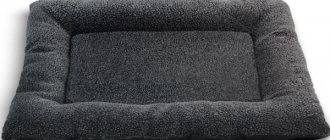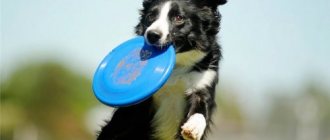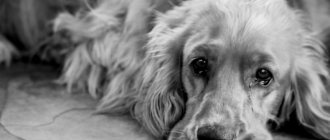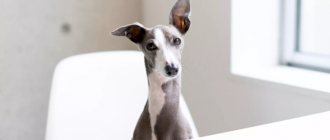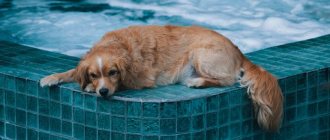There are many reasons why dogs may not instinctively engage in play with their human owners. For example, a dog kept in a kennel for breeding may have few positive interactions or experiences with people.
If your dog or puppy is anxious or unwilling to interact with you, you can earn their trust through a slow, gentle socialization process. Once your pet feels comfortable with you, he can learn to play and have fun.
The importance of the game
While some dog owners may not care whether their dog is playful, there are a number of benefits to playing with your dog and puppy:
- Play offers dogs mental stimulation and a way to burn off energy.
- Play is a great way to strengthen the bond between you and your dog.
- Play is a great way to reward your dog for learning new skills.
- Fun to play! Just like with people, games and activities that they enjoy improve a dog's quality of life.
Patience is your most important tool.
It may take time for dogs to begin to trust their owners and even longer to learn appropriate ways of interacting.
Remember, however, that your goal is not to encourage your dog to do whatever he wants in any way he wants; rather, you are teaching him to interact with you by following the rules and expectations you want to set.
Therefore, it is important to have a clear understanding of the boundaries and types of play that are acceptable to you. Make sure everyone who works with your dog understands your goals, rules and expectations.
For example, your neighbor might think it's cute when your dog growls while holding a toy in his mouth, when you've set a rule that growling is not acceptable. Naturally, different sets of rules and different types of play will be confusing for your new pet.
Complicated fetching
A more complex version of training trains endurance and obedience. The animal learns not only to fetch things, but also to carry them next to the owner.
Edible item
After mastering basic fetch, the toy can be replaced with a cracker, a piece of cheese or another edible product. It is very important to motivate your pet here. For every success, he should receive not only praise, but also a more tasty morsel.
Carry an object nearby
This skill is trained after memorizing the command “Nearby”. Ultimately, the dog must hold the toy in its teeth and walk with its owner in the same direction. A successful demonstration of skills will reward you with a generous treat.
Start slowly
There are several reasons why a dog might not learn to play. One of the common reasons is the lack of early socialization. Some dogs don't play simply because no one has ever played with them.
Another reason is that their instincts may lead them to do other things. For example, a Border Collie may want to gather your children in the yard rather than engage in a game of fetch.
Regardless of why your dog isn't playing, you should start by gradually introducing him to toys and games. Start by leaving the toys out for the puppies to sniff the toys and get used to them, rather than jumping right into an all-out game of tug of war.
An improperly socialized dog may become afraid if you move too quickly, while a dog whose instincts are pushing him to do something else will simply become confused.
Why is a pet attached to a specific thing?
Scientists cannot yet give a concrete answer to this question. To find out the reasons for a furry pet's attachment to a specific thing, a special study will be conducted, including a survey.
The topic is really relevant. In the United States, the pet toy market recently crossed the billion-dollar threshold. In the UK, buying your pet a Christmas present is a tradition.
The University of Bristol Veterinary School and the School of Psychological Science want to hear from dog owners to better understand the evolution of social behavior in animals.
Teach the rules
Sometimes teaching a dog to play involves more than just slowly introducing the idea. For example, games such as “fetch” or “furch” in the English version consist of several parts.
It may be easy to teach your dog to run and pick up a ball that you throw, but he needs to know the commands “come” and “throw” to keep the game flowing smoothly without turning into a game of chasing.
If your dog has trouble playing, make sure he knows the basic commands needed to play.
Purpose of the "Aport" command
“Fetch” combines 3 actions: chasing an object, picking it up and bringing it to the owner. During training and subsequent demonstration of the skill, the pet receives the following benefits:
- Becomes one step closer to passing the OKD, where correct fetching is an important part of the final exam.
- Learns logical thinking. Unlike most skills, there is a specific sequence that needs to be remembered.
- Learns to control your emotions. Fulfilling an order should be higher than the excitement of the game.
- Develops orientation in space. A trained dog easily tracks the direction of a thrown object and does not lose track.
- Releases accumulated energy. Regular physical exercise helps prevent obesity and musculoskeletal diseases.
- Establishes a connection with the owner. Playing games together is not only fun, but also an effective way to form affection.
Hunting and service breeds are the easiest to train. Despite this, with due persistence, ordinary companion dogs can also master fetching.
The skill is required for passing OKD and more difficult disciplines (ZKS, service and rescue training), available after completing the general course. In all other cases, training is carried out solely at the request of the owner.
Problems with behavior while playing
It is difficult for a dog to play properly when he is in a new, exciting environment or playing with unfamiliar people or animals.
To test your dog's new play skills, you will want to put him in different situations to see how well he retains his skills.
- Take your dog to a dog park and see if he can continue to attend and follow your play rules when other dogs are nearby.
- Let other people play with your dog by asking them to do the same thing, but using a different tone or a different set of toys.
- Observe how your dog responds to commands from a young child, who may not have the same authoritative tone as you.
If you find that your dog hasn't really learned the rules of the game, you may need to go back to previous steps in the process.
- Make sure your dog is truly comfortable in your home and trusts you and anyone else who interacts with him regularly.
- Re-teach the commands you will use, such as “drop,” “come,” and “fetch.”
- Take the time to introduce your dog to the different environments and people he might encounter on a regular basis. Repeat training with these people and settings as needed.
For this type of training, patience is key; if you move too fast, you may lose your dog's trust.
How to teach a puppy to play with his toys
Published on February 23, 2022 in Puppy For a small puppy (as well as for a small child), all surrounding objects are toys. Puppies do not have hands, so they explore the world around them using their mouths. They taste all the objects they find, determining whether it is edible, whether it can be played with, or whether it is dangerous. Now think for a minute: is there anything in the natural habitat of dogs (garbage dumps, outskirts of villages) that a puppy could bite and that would not bite him back, so that his mother would be very upset? Is there a division in nature into “toys” and “not toys”? No. In nature there is only a division into “dangerous” (what will kill or injure you) and “safe” (what will not kill or injure you). Safe is a “toy”, dangerous is “not a toy”. You can't play with something dangerous, but you can play with everything else.
Problems begin when the puppy enters the “illogical” world of people with their strange obsession with categories. Nature's program tells him that he should not play only with dangerous things. The person tells him that most things that are safe are also not allowed to be played with, and expects the puppy to figure out what those things are. Imagine that I put ten different balls in front of you. Some of them can be touched, and some cannot be touched. How do you know which ones are which? For a puppy, these are all toys, and it is your task as the owner to teach him which ones can be touched and which ones cannot.
How will you teach him this? If you are an ordinary person (especially a representative of Western culture), you will most likely stand on the sidelines, and when the puppy makes a mistake, you will punish him. Shout “no,” scold him, slap him with a rolled-up newspaper, shake him by the scruff of the neck, and so on.
So, in front of you are ten balls, different in color and size. There are balls with a pair, and there are those without a pair. I decided which ones I could touch and which ones I couldn’t. Now you have to tell me which balls are which. If you guess correctly, I will give you a million rubles. You touch one, the other... And then I sharply cry out, “Stupid!” and, perhaps, I will hit you in the shin with the toe of my boot (if you prefer more “intelligible” punishments). Introduced? Did you feel it? Keep touching... Another scream and a blow to the shin. Continue.
If I were Mother Nature, you would very quickly determine which ones can be touched and which ones cannot be touched: some are scolded, others are not. But, unfortunately, I am a human. Sometimes I get lost in my thoughts and don’t notice how you touch the “forbidden” ball. Sometimes I react late and punish you for the previous “forbidden” ball when you are already touching another (it may well be “allowed”). Do you have the patience to complete this task? Or will you rather think that this million is not worth your nerves, that I am a sick psychopath, and that it is better to sit quietly, not touching anything, until the orderlies you called come for me?
Punishment teaches the puppy only one thing - not to do anything while this unpredictable psycho is around. But when the owner leaves... or the puppy goes into another room... oh, hold on, socks, flowers and baseboards! And even if at this moment you come in and catch him red-handed, he will associate the punishment not with his occupation, but with you. These “toys” are not “dangerous”: he just played with them for 5 minutes without harm to his health. You are “dangerous”!
Let's go back to our ten balls again. You touch the first one - I smile and say “that’s right.” You reach out to the second one, and a barrier appears on your way. A few attempts, and the thought creeps in: “maybe these balls shouldn’t be touched?” How quickly will you solve all the balls in this case? This is training according to the “golden principle”: I reward you with praise for correct actions and do not allow you to do the wrong action (touch the “forbidden” ball). And at the end you also receive a million rubles!
Train your puppy to distinguish “toys” from “non-toys” using the same principle. Reward him for interacting with the “right” toys and don’t let him interact with the “wrong” ones (don’t let that interaction be reinforced). Sounds simple.
Speaking about toys, it’s worth saying a few words about motivation. Motivation is the driving force of any activity. Motivation is based on some need that the animal wants to satisfy. And in the world around there are dozens or hundreds (or even thousands) of ways to satisfy it - objects. In simple words, motivation is the animal’s desire to satisfy an existing need with a given specific object. Different objects can satisfy the same need with different success, and the level of motivation associated with each object will also be different. Sounds complicated.
In the chapter on the “magic button,” I give an example of choosing between potatoes and sweet potatoes. These are two items that can satisfy one need - food. In this example, the motivation to eat potatoes will be higher than the motivation to eat sweet potatoes, so you will buy potatoes. It will be higher because you are familiar with potatoes, but you are seeing sweet potatoes for the first time and know nothing about them. Of course, many other factors besides history of reinforcement influence motivation levels, but these are beyond the scope of this book.
What does all this have to do with toys? With the help of toys, the puppy satisfies his various needs, of which he has many. And our task as owners is to provide him with suitable items to satisfy each of these needs, otherwise he will be forced to find these items himself (and you probably won’t like his choice!)
The most obvious need a small puppy needs toys to satisfy is to help with teething and changing teeth. I heard an interesting theory from one of the Western trainers (unfortunately, I don’t remember his name) that puppies have two periods of changing teeth. The first is the well-known period when baby teeth fall out and permanent teeth come out in their place. At this time, the puppy prefers to chew soft, “sticky” things (for example, textiles, soft rubber), since they “help” the baby teeth fall out. It lasts up to 4 – 4.5 months. The second period of teeth change occurs at 7-10 months, when the puppy’s jaw bones complete growth and the molars take their final position. During this period, the puppy prefers to chew hard things (for example, wood, hard rubber). This means that for a small puppy you should provide more soft toys (rags, ropes, soft Kong, plush toys), and as they grow older, shift the balance towards hard toys (special synthetic sticks and bones, hard Kong, thick ropes with knots).
The most unobvious need of a small puppy is the need for an enriched environment. This is the need to constantly gain new experiences. A puppy needs to explore the world around him, if not by teeth, then at least by his tongue, ears, paws and tail. And he should do this under your supervision and guidance, so that you teach him in real time the rules of interaction with these things. Yes, you can bite leaves and pieces of paper, but you can’t bite a cat; You can lick the cat (if he doesn’t mind, of course). If you do not teach him these rules, he will come up with them himself, and then you will spend a painfully long time changing his “fun” rules for your “boring” ones. Speaking of rules, animals consider the first experience they receive to be the rule, and subsequent experiences as exceptions to this rule. In other words, if he secretly steals a sock and plays with it, he will explain your subsequent prohibitions on playing with socks by the fact that you are in a bad mood today, and not by the fact that in principle you cannot play with socks. In general, teach your puppy to do everything correctly from the very beginning. Sounds familiar, right?
There are owners who leave no toys for their puppy at all. There are owners who leave the same few toys to the puppy, and then wonder why he chews shoes and tears off wallpaper, because he has his own toys. If you are one of them, imagine that you are sitting alone in a white room for several weeks, where for entertainment you have a fairy tale about Kolobok, a crossword puzzle (one!) and one episode of your favorite TV series. Are you bored? But you have these magnificent varied entertainments!
A puppy must have toys! Interesting and new. There doesn’t have to be a lot of them: you can constantly change them, every 2-3 days putting one of the toys in the closet and taking out another in its place. This way, every week the puppy will have a new set of toys, and he will not have time to get bored with them. The ball that he has been contemplating for several weeks in a row will interest him no more than you will be interested in a solved crossword puzzle. Tearing off wallpaper is much more interesting.
When choosing toys, it is very important to consider your puppy's play style. In the game, puppies practice individual links of the hunting chain. Behind each individual link there is a separate need for the implementation of this behavior. The level of need depends on the breed (for what purposes it was bred) and on the individual characteristics of the puppy.
The hunting chain is as follows: search - detection - stalking - pursuit - grabbing bite - killing bite (and/or head shaking) - dismemberment - eating.
Depending on the breed and individual characteristics, some links in this chain may be absent, and some may be hypertrophied. If the puppy is trying to satisfy the need for searching (climbs on the kitchen table, sticks his nose in the trash can, digs a hole in the sofa), then he needs to be provided with toys that will allow him to satisfy it. A rubber bone and a skin with a squeaker will not help here, but search games and puzzles where you need to find and extract pieces of food will do. If he likes to "dismember", give him cardboard boxes or a bundle of scraps as an alternative, which he can tear into pieces with impunity. (Make sure he spits out what he chews! If he swallows, these toys are not suitable for him; try a hard Kong).
Try to determine which link of the hunting chain the puppy implements when playing with a given “forbidden” object, and give him a “permitted” alternative that allows him to carry out this behavior.
Finally, let's talk about the most common mistake. For many owners, the temptation to run after the puppy and try to take away stolen “forbidden” things from him is too great. Unfortunately, this game of catch-up is the greatest reward for playing with these very things. This will only encourage and strengthen the behavior of the puppy you want to get rid of. There is no good solution to this problem! If the puppy is already playing with a “forbidden” thing, any action you take will worsen the situation. You can only choose the lesser evil. This lesser evil would be ignoring the puppy (if he took possession of a “safe” object) or exchanging (if he took possession of a “dangerous” object). The greatest of evils is forcibly taking things away from him and/or punishment. (You will learn more about exchanging and taking items in the chapter on protecting resources).
The only good solution to the problem of playing with “forbidden” things is to prevent it. Don't give your puppy the opportunity to engage in unwanted play. To do this, he must either be under your active supervision, or his movement must be limited using a cage, playpen or leash (to himself or to furniture near his resting place). In addition, provide your puppy with a variety of new and interesting (appropriate for his play style) toys and be sure to praise and reward him for interacting with them. A good option for a toy is Kong - it is both quite soft and quite hard, it can be chewed, can be licked, can be searched by smell and can be thrown, caught and chased. One toy can satisfy almost all hunting needs. And most importantly, the food obtained from it reinforces the game with it, increasing the motivation to play with Kong, and not with other objects. However, a warm smile, kind words and soft stroking will never be superfluous.
It's easy to save your home from destruction and your puppy from electric shock. To do this, you need to either isolate all valuable and dangerous things from the puppy, or isolate the puppy from them, and offer him interesting alternative toys, interaction with which is richly rewarded. At the same time, explore the world around you with your puppy, teaching him the rules of behavior and handling certain things. Before you even blink an eye, your puppy will become a trustworthy and well-mannered furry citizen!
Share link:
What can help in training a dog?
It is also important to take into account upbringing. After all, any game requires the owner’s ability to pacify the pet’s ardor. To make your dog calmer after active entertainment, we recommend that you take a walk at a moderate pace. To begin with, it can be a fast run, and only then slow down. This way, the dog will understand that he needs to go home soon.
In order for your dog to really begin to obey you, try to gradually teach him commands. That is, do not make this a task of first importance if you are not going to competitions. But also try to train according to a specific schedule. During classes, show confidence, both in intonation and behavior.
Nothing helps? We have an online school. Sign up!
Find out more
sign up
Questions and Answers: Why does a dog play around at home?
Quite often, owners pay attention to the unacceptable behavior of their pet at home, its barking in the absence of the owners. This behavior is noticed in cases where the dog is not given enough time for physical relaxation. It’s especially problematic when you take a pet into your apartment and it bothers your neighbors.
Please note that breeds such as beagles, poodles, as well as pit bulls, huskies and others require a long walk, active games and have innate inclinations to learn many commands. It is important to direct your pet’s activity in the right direction, then you will have no reason to think about why the dog is playing around or not listening. You should not express dissatisfaction when trying to train your dog. Patience and a painstaking approach are important.
There are many interesting games for dogs that can be used to diversify their stay both at home and outside. Try to also have fun with your pet, but remain in the position of the owner. This means that while raising a dog, it should be offered more than just games. Training, communication and teaching norms are also important.
